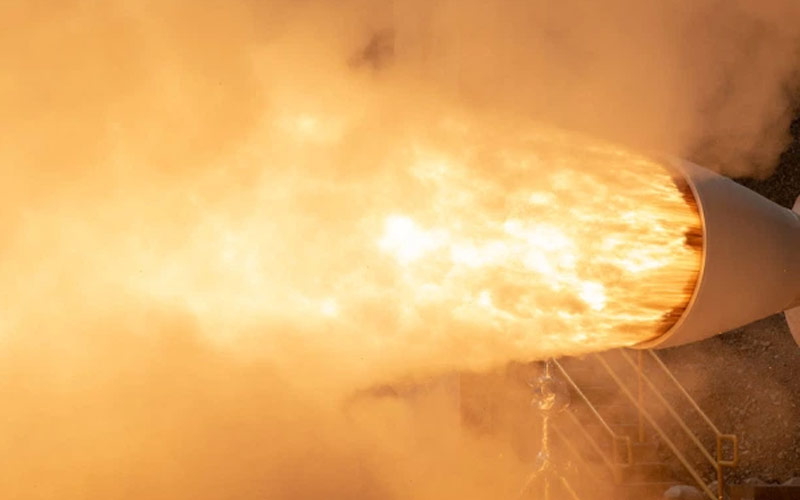Todd Mott: Clearing the Smoke on Data Reduction

By Brooks McKinney, APR
Whenever Northrop Grumman conducts a static test of the new five-segment Flight Support Booster (FSB) has developed for NASA's Space Launch System, hundreds of test instruments attached to the rocket generate millions of data points through thousands of data channels. Most of this raw data — presented as voltage or bit count — is indecipherable, even to the hundred or so test engineers involved with the company's FSB test program in Promontory, Utah.

Reformatting Reality for Rocket Development
That's where Todd "The Data Man" Mott, principal energetics engineer for the Propulsion Systems Division, comes in. A specialist in data reduction, Mott collects, manages, and then translates raw test data into formats that can be easily understood and analyzed by test engineers.
"Test data gets recorded initially to several data systems, each one using a unique format to store its data," explains Mott. "I use software to convert that raw data into engineering units such as pressure, displacement or load — something that's meaningful to my internal customers."
Those customers use Mott's data to evaluate the design and performance of a rocket. Sometimes, they also ask him to convert the data into forms that can be used to explain propulsion system test results more easily to external customers.

Ensuring Accuracy on the Launch Pad
Mott, who's been with the company for 42 years, reduces data for a variety of Northrop Grumman propulsion system test programs, including the Shuttle-derived 5 segment boosters, the company-funded Graphite Epoxy Motor (GEM)-63XL for United Launch Alliance's new Vulcan Centaur launch vehicle and the Trident II D-5 missile.
One type of test data he manages frequently relates to the alignment of rocket motors and their nozzle. A rocket nozzle causes hot gases generated by the combustion of rocket propellants to accelerate out the back of the rocket, creating thrust that propels the rocket forward.
"We need to ensure that the center of thrust created by a rocket motor is perpendicular to the thrust block," explains Mott. "When the motor fires, the center of force will push against this thrust block. Accurate alignment of motor and nozzles helps guarantee that our instruments correctly measure the thrust produced by the rocket."
"When I started my career 42 years ago, we were recording data on strip charts. To reduce that data, we had to take measurements, write down numbers and then do our calculations. Today, of course, it's all electronic."
— Todd “The Data Man” Mott, Principal Energetics Engineer
Looking for Trouble Using Data Points
Mott also manages innumerable data related to the integrity of the rocket motor case itself.
"During static tests of our Space Launch System booster, our test engineers measure all the different forces that could cause the booster to fail prematurely," he explains. "For example, they measure the pressure inside the rocket case, the strain on the actual case materials, the levels of vibration the case is experiencing, the temperature of the case and the degree to which different parts of the rocket are displaced when the motor is firing."
The test team uses the products of Mott's data reduction to evaluate the strength and performance of the rocket motor case during launch — a key factor in determining the overall performance of the motor.
Measuring Twice, Firing Once
Mott's data reduction work actually begins long before an actual test takes place. For example, he helps the test team figure out how to best record and format the data that will come from the test. He also reduces data from "dry runs" to ensure that he and the test team are on the same page.
"We do everything except push the actual fire button multiple times to make sure we're going to do the test right and that we're going to get the right results," he emphasizes.

Marching Forward
Major tests of the Space Launch System boosters occur about once every two years, but that fact belies Northrop Grumman's actual level of testing.
"We regularly perform acceptance testing on some major component of the FSBs to support production," Mott explains. "For example, we test subscale FSB motors to evaluate the performance of the propellant; igniters used to start the rocket; and booster separation motors used to 'push' the rocket away from the core space vehicle once they have finished their job."
He and his colleagues also stay busy testing the company's GEM-63 XL rocket motor.
Managing Change in Data Reduction
Over the years, Mott has seen many changes to his data reduction processes — some positive, others he'd like to bring back.
"When I started my career 42 years ago, we were recording data on strip charts. To reduce that data, we had to take measurements, write down numbers and then do our calculations. Today, of course, it's all electronic."
Keeping It Interesting
Even with all the updates to technology and high performance computing available, data reduction is still a job that makes Mott's heart sing. He loves the variety of test scenarios and data types that cross his digital desk. And he's pretty sure his customers value his ability to quickly sort, translate and reformat their test data.
"The one aspect that remains interesting and fun for me is that I'm the first one who gets to see the data," he observes. "That also means that sometimes I'm the first one to know that we have a problem. I like those pressure-filled times, though, because I get to help decide if we have a data problem, an instrumentation problem or a rocket motor problem. And that's when I'm reminded that I'm still an important part of a really great team."
More innovation stories
Read all stories about advanced technology and innovation >>


